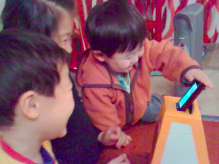One of my favorite conferences, Interaction Design and Children (IDC) is going to be in NYC this year! Full papers are called for on January 22nd and I hope to see a lot of great stuff this year (definitely excited about the paper I will be submitting :-)). In the meantime, I wanted to reflect on some of my favorite IDC papers of all time. These are the ones that have directly influenced my own work and I wanted to share them with others who are interested in family communication technologies.
The first paper is about Mediated Intimacy in Families and it is a qualitative investigation of how parents and children build closeness. Dalsgaard et al. emphasize the importance of emotional and physical expressiveness in all relationships. But they also found differences: parents and children build closeness through play together and care provided by the parent for the child, rather than through reciprocal exchanges and setting of public and private boundaries (as in strong-tie relationship). These insights led quite directly to the work that I’ve done with the ShareTable, where my goal was supporting the kinds of care and play activities that might be done remotely.

Freed et al. used a doll house to investigate how children think about remote communication. This image is from their paper and belongs to the authors.
The second paper is about children connecting with peers through tangible characters in doll houses. Freed et al. built a pair of doll houses where toys could call each other, mail letters, and videochat with each other. This is a cool idea and an interesting way of investigating how children think about remote communication. The dollhouse approach turned out to be quite compelling to the kids, with most of them engaging in some level of shared play and finding the experience engaging. I had already been engaging with the idea of communicating through play, but seeing this work eventually inspired me to think about physical arrangements for videochat that could support narrative and pretend play.

Raffle et al. investigated asynchronous messaging with toddlers. This image is from their paper and belongs to the authors.
The last paper is about asynchronous messaging with preschoolers. If you had asked me before this paper was published whether I thought that asynchronous communication with toddlers would work, I would probably have been very dubious. It’s just not that easy to communicate remotely and it seems much easier to connect with a person than with a message! I have to say that this paper has changed my mind. It presents three prototypes for asynchronous contact that thoughtfully explore what it may look like to engage toddlers with remote relatives asynchronously. This hasn’t led me to do a new paper or a new project (yet), but it reminded me not to underestimate the power of creative ideas and the ability of children to adapt to new ways of connecting.
If you like these papers, you might thing about checking out IDC in NYC this year. I’ll definitely be there, so let me know if you want to meet up.
